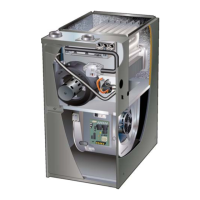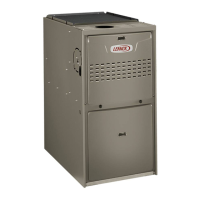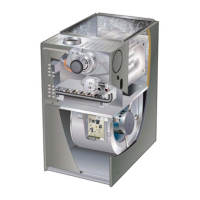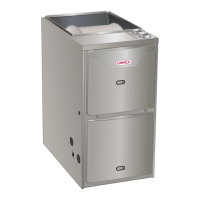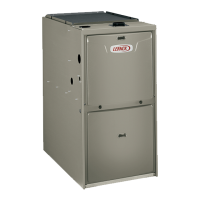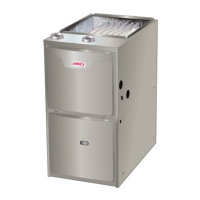Page 52
Single Stage Cooling
A call for cooling from the thermostat closes the R to Y
circuit on the integrated ignition/blower control board. The
control waits for a 1-second delay before energizing the
circulating blower to 82% of the selected cooling CFM
(passive dehumidication mode). After 7.5 minutes, the
circulating blower automatically ramps up to 100% of the
selected cooling airow. When the call for cooling is satis-
ed, the circulating blower ramps back down to 82% of the
selected cooling airow for 1 minute, then shuts o.
Two-Stage Cooling
A call for 1st stage cooling from the thermostat closes the
R to Y circuit on the control board. The control waits for a
1- second delay before energizing the circulating blower.
The blower motor runs at 57% of the selected air ow for
the rst 7.5 minutes of the 1st stage cooling demand (pas-
sive dehumidication mode). After 7.5 minutes, the blower
motor runs at 70% of the selected cooling air ow until
1st stage cooling demand is satised. A call for 2nd stage
cooling from the thermostat closes the R to Y2 circuit on
the control board. The blower motor ramps up to 100% of
the selected cooling air ow. When the demand for cooling
is met, the blower ramps down to Y1 until satised, then
ramps down to 57% for 1 minute, then turns o.
Heat Pump
For heat pump operation, clip the jumper wire located bel-
low the O terminal on the integrated ignition/blower control
board. In heat pump mode, a call for heat will result in the
circulating air blower operating at the selected cooling air-
ow after a brief ramp-up period.
Emergency Replacement Motor Operation
If the variable speed motor needs to be replaced in an
emergency situation (such as “no heat”) and an exact re-
placement motor is not immediately available, a standard
PSC motor of equivalent frame size, voltage, rotation, and
horsepower can be temporarily installed until the correct
replacement motor can be obtained.
Connect the desired speed tap to the “EAC” terminal and
the neutral tap to the neutral terminal on the ignition con-
trol (refer to the furnace wiring diagram). The ignition con-
trol will control the motor’s operation, including a nominal
20 second “on” delay with a call for heat and a nominal
180 second “o” delay when the thermostat is satised. It
will also operate the motor on a call for cooling, with no
“on” or “o” delays.
Verify that the unit is operating at the desired speed and
within the rise range as shown on the unit rating plate. The
correct replacement motor must be installed as soon
as possible to ensure continued satisfactory opera-
tion of the furnace.
Service
WARNING
ELECTRICAL SHOCK, FIRE,
OR EXPLOSION HAZARD.
Failure to follow safety warnings exactly could result in
dangerous operation, serious injury, death or property
damage.
Improper servicing could result in dangerous operation,
serious injury, death, or property damage. Before
servicing, disconnect all electrical power to furnace.
When servicing controls, label all wires prior to
disconnecting. Take care to reconnect wires correctly.
Verify proper operation after servicing.
WARNING
The blower access panel must be securely in place when
the blower and burners are operating. Gas fumes, which
could contain carbon monoxide, can be drawn into living
space resulting in personal injury or death.
Annual Furnace Maintenance
At the beginning of each heating season, and to comply
with the Lennox Limited Warranty, your system should
be checked as follows:
1 - Check wiring for loose connections, voltage at
indoor unit and amperage of indoor motor.
2- Check the condition of the belt and shaft bearings if
applicable.
3- Inspect all gas pipe and connections for leaks.
4- Check the cleanliness of lters and change if
necessary (monthly).
5- Check the condition and cleanliness of burners and
heat exchanger and clean if necessary.
6- Check the cleanliness of blower assembly and
clean the housing, blower wheel and blower motor if
necessary.
7- Inspect the condensate drain and trap for leaks and
cracks. The drain and trap must also be cleaned
and the trap must be primed with water. Inspect the
rubber hoses connected to the pressure switches for
cracks or loose connections, replace as necessary.
Remove the rubber hoses from the cold end header
box and inspect for any blockage, clean as needed.
If strainers are installed in the hoses remember to
remove and clean before reinstalling the hoses.

